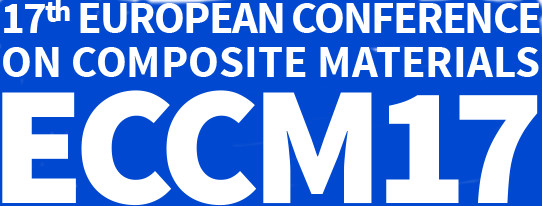

App-Einstellungen:
Information
Here you can download the papers of the ECCM17 separately. They are sorted by their presentation ID.
A THERMODYNAMICALLY BASED WORK POTENTIAL THEORY FOR PREDICTING PROGRESSIVE DAMAGE AND FAILURE IN 3D TEXTILE COMPOSITES
Sam Huang (New York State University at Stony Brook) Evan Pineda (NASA)
In this paper, a 3D thermodynamically-based work potential theory for modeling progressive damage for laminated, unidirectional composites,extend from 2D Schapery's theory, is used to predict the response of textile composites.
CHRARACTERIZATION OF INTERFACIAL STRENGTH BETWEEN FIBER AND MATRIX BASED ON IMAGE ANALYSIS OF PHOTOELASTICITY
Kosuke Takahashi (Hokkaido University) Bentang Arief Budiman (Tokyo Institute of Technology) Kazuaki Inaba (Tokyo Institute of Technology) Kikuo Kishimoto (Tokyo Institute of Technology)
Interfacial strength between fiber and matrix is evaluated by stress contour observed in photoelastic images of single fiber fragmentation test, based on non-rigid bonding model of a cohesive surface.
COMBINED FE/STATISTICAL APPROACH FOR THE STRENGTH OF COMPOSITE FIBRE BUNDLES CONSIDERING HIERARCHICAL FAILURE
Gaël Grail (Imperial College London) Marie Coq (Imperial College London) Charlotte Guesdon (Imperial College London) Soraia Pimenta (Imperial College London) Silvestre Pinho (Imperial College London) Paul Robinson (Imperial College London)
A hierarchical model for the strength of composite fibre bundles is presented, which takes into account the stochastic single fibre strength distribution and realistic full stress fields around clusters of any size, predicted with FE.
COMPOSITE MATERIALS UNDER TRANSVERSE BIAXIAL LOADS: STUDY OF THE INFLUENCE OF A NEARBY FIBRE ON THE INTERFACE CRACK GROWTH UNDER TENSION.
Carlos Sandino (University of Seville) Elena Correa (University of Seville) Federico París (Universidad de Sevilla)
The interface crack growth associated with the inter-fibre failure under biaxial tension is studied by means BEM model. The influence of a secondary fibre on the evolution of an interface crack is analysed using Interfacial Fracture Mechanics.
COMPOSITE MICRO-SCALE MODEL ACCOUNTING FOR DEBONDING, STRAIN RATE-DEPENDENCE AND DAMAGE UNDER IMPACT USING AN EXPLICIT FINITE ELEMENT SOLVER
Francisco A. Gilabert (Ghent University) David Garoz Gomez (Ghent University) Ruben Sevenois (Ghent University) Siebe Spronk (Ghent University) Ali Rezaei (Ghent University) Wim Van Paepegem (Ghent University)
This work presents a micro-scale simulation model that can be used to analyze the mechanical response of UD composites undergoing high strain rates. The model includes features like fiber-matrix debonding, strain-rate dependency and matrix failure.
COMPUTATIONAL MICROMECHANICS ON POLYMER MATRIX COMPOSITES UNDER DIFFERENT ENVIRONMENTS: LONGITUDINAL, TRANSVERSE AND SHEAR PLY PROPERTIES
Fernando Naya (IMDEA Materials Institute) Claudio Lopes (IMDEA Materials Institute) Carlos González (Polytechnic University of Madrid & IMDEA Materials Institute)
A coupled experimental-computational micromechanical framework to determine the mechanical properties of unidirectional composites under RT/DRY and HOT/WET conditions is described in this paper.
DETECTION OF MICROCRACK INITIATION IN EPOXY MATRIX MATERIAL WITH USE OF ACOUSTIC EMISSION
Krzysztof Konsztowicz (University of Bielsko-Biala) Marek Nowak (Cracow University of Technology) Ireneusz Baran (Cracow University of Technology) Magdalena Ziąbka (AGH University of Science and Technology) Jan Chłopek (AGH University of Science and Technology)
Detection of micro-crack initiation in neat epoxy resin was studied in SBS tests using Acoustic Emission and SEM. Micro-cracks with size of a few μm and more were found before failure, forming near structural irregularities of epoxy resin.
DISCRETIZING THE DEFORMATION WITHIN A STRESS BASED FUNCTIONALLY GRADED INTERPHASE IN A MICROMECHANICS COMPOSITE MODEL
Trevor Sabiston (University of Waterloo) Mohsen Mohammadi (University of New Brunswick) Mohammed Cherkaoui (Georgia Institute of Technology) Kaan Inal (University of Waterloo)
A new micromechanics frame work is proposed, where a functionally graded interphase is used to account for the force transfer between the matrix and the reinforcements to predict the multi-axial response of unidirectional composites.
EVALUATION OF INTERFACIAL STRENGTH IN MICRODROPLET TEST USING EXPERIMENT AND COMPUTATIONAL SIMULATION
Mio Sato (Tokyo University of Science) Erina Imai (Tokyo University of Science) Jun Koyanagi (Tokyo University of Science)
This paper presents an evaluation method for fiber/matrix interfacial strength. In this study, we determine interfacial strength by comparing experimental data with FEM computational simulations of the microdroplet tests.
